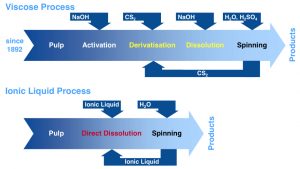To read the full article, please login. The full content of this article and all premium articles is available exclusively for site members.
Site membership is free. If you are an existing user, please login. New users may register below.
Enzymes – an alternative for wet processing of denim
Enzymes – an alternative for wet processing of denim Garment wet processing is gaining popularity since several years. Especially for denim fabrics the treatment of garments is common, because of certain effects which can be only carried out on a ready-made garment and not on a flat fabric. Apart from washing and cleaning, it can impart artistic and innovative look to the garments. However, textile wet processing using chemicals is one of the pollution causing processes in the mills. Denim garment manufactures use numbers of acutely toxic chemicals of which many are classified as hazardous by the WHO.[1] Several denim brands have committed to eliminate the release of all hazardous chemicals throughout its entire supply chain and products. In response to the Greenpeace Detox campaign, a group of major apparel and footwear brands and retailers made a shared commitment to help lead the industry towards zero discharge of hazardous chemicals (ZDHC) by 2020.[2] Denim wet processing with enzymes is a possible alternative, which can at the same time reduce energy costs, water consumption and the eluent load. Introduction The use of enzymes allows the development of environmentally friendly technologies in processing and strategies to improve the final product. The biotechnology industry continuously develops innovative enzymes with unique performance features for existing and new applications. Enzymes aim to provide in the complete process a reduction of process time, chemical and energy consumption, in compliance with sustainable developments. The technical background of enzymes was descripted in an earlier report.[3] This report gives an overview of the use of enzymes compared to traditional applications in the garment process of denim fabrics. Usually the following sequence is applied: Desizing For fabrics made from cotton or blends, the warp threads are coated to prevent threads breakings during weaving. Although many different compounds have been used to size fabrics, starch and its derivatives have been the most common sizing agent for denim fabrics. After weaving, the size must be removed again in order to prepare the fabric for dyeing and finishing. Figure 1: Comparison of a chemical and an enzymatic desizing process[4]This desizing process must be carried out by treating the fabric with chemicals such as acids, alkali or oxidizing agents. However, amylases as starch breaking enzymes are preferred for desizing due to their high efficiency and specific action. Amylases have been used for desizing already since the middle of the last century. Amylases bring about complete removal of the size without any harmful effects and damages of the fabric. Another benefit of enzymes compared to strong chemicals is that enzymes are environmentally friendly. Figure 2: TEGEWA color test for starch sized cotton Scouring A very important process is scouring. In this process, non-cellulosic components from native cotton are completely removed. Scouring is the process of purifying cotton fabrics from impurities such as wax, pectin, hemicelluloses and mineral salts. Pectin acts like glue between the fiber core and the waxes which can be destroyed by an Alkaline Pectinase Enzyme. Scouring provides to a fabric a high



